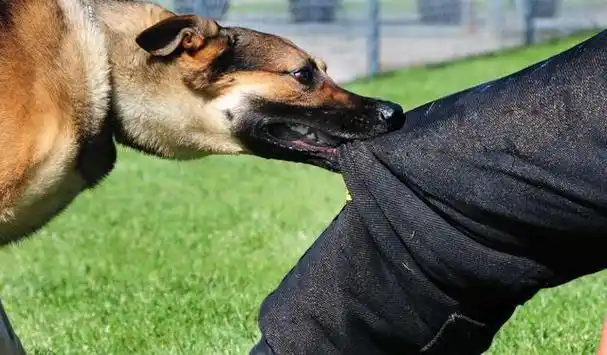Many dog owners face the challenge of their dogs jumping on people, especially larger breeds that can easily knock someone over. While this behavior often stems from excitement or a desire for attention, it can be problematic, especially for visitors or children. This article will explore why dogs jump on people, the potential risks involved, and effective strategies for correcting this behavior.

1. Understanding Why Dogs Jump on People
Why Do Dogs Exhibit Jumping Behavior?
Dogs are naturally social animals, and jumping is often a way for them to greet and engage with people. Here are some common reasons why dogs jump:
- Excitement: Dogs may jump when they see their owners after a long day or when meeting new people.
- Attention Seeking: Jumping can be a way for dogs to get noticed, especially if they have learned that this behavior gets them attention, even if it’s negative.
- Playfulness: Jumping is often part of a dog’s play behavior and can be an invitation to engage.
Understanding these motivations can help owners address the root cause of the jumping behavior.
2. The Risks of Dogs Jumping on People
Why Is This Behavior Problematic?
Jumping can lead to various issues:
- Injuries: Larger dogs can easily knock over smaller individuals, children, or elderly people, leading to potential injuries.
- Social Situations: Jumping can create uncomfortable situations during social gatherings, leading to stress for both the owner and guests.
- Misinterpretation: People unfamiliar with dogs may misinterpret jumping as aggression or poor behavior, leading to negative perceptions of the dog.
Recognizing the risks can motivate owners to take action to correct this behavior.
3. Training Techniques to Stop Jumping
Effective Methods to Correct Jumping Behavior
Several training techniques can be employed to teach dogs not to jump:
- Ignore the Behavior: When your dog jumps, turn away and avoid eye contact. This teaches them that jumping does not result in attention.
- Reward Calm Behavior: When your dog remains calm during greetings, reward them with treats and praise. This reinforces the behavior you want to see.
- Use Commands: Teach commands like “sit” or “down.” Encourage your dog to sit when greeting people, rewarding them for following the command.
- Redirect with Toys: Provide a toy for your dog to hold onto when greeting people. This redirects their energy and attention away from jumping.
Implementing consistent training techniques is crucial for success.
4. Consistency and Patience in Training
The Importance of Consistency
Training a dog to stop jumping requires consistent reinforcement:
- Everyone Should Participate: Ensure that all family members and regular visitors use the same techniques and commands to avoid confusion.
- Be Patient: Changing behavior takes time, so remain patient and persistent. Celebrate small victories along the way.
Understanding that consistency and patience are key components of successful training can help owners stay committed.
5. Seeking Professional Help
When to Consult a Dog Trainer
If jumping behavior persists despite your efforts, consider seeking professional assistance:
- Dog Trainers: Professional trainers can offer personalized guidance and techniques tailored to your dog’s specific needs.
- Behaviorists: A certified animal behaviorist can provide deeper insights into your dog’s behavior and develop a comprehensive training plan.
Knowing when to seek professional help can make a significant difference in training effectiveness.
6. Managing Jumping in Different Situations
Tips for Different Environments
Dogs may behave differently depending on the situation. Here are some tips for managing jumping in various environments:
- At Home: Encourage guests to ignore your dog until they are calm before giving attention.
- In Public: Keep your dog on a leash and practice commands in busy areas to reduce jumping.
- During Playdates: Monitor interactions with other dogs and redirect jumping behavior by encouraging play without jumping.
Adapting training techniques to different situations can enhance their effectiveness.
7. Alternatives to Jumping for Greeting
Teaching Appropriate Greeting Behaviors
Teaching your dog alternative ways to greet people can also help reduce jumping:
- Teach “Four on the Floor”: Encourage your dog to keep all four paws on the ground when greeting others.
- Use a Leash: Keep your dog on a leash during introductions to maintain control and prevent jumping.
- Controlled Greetings: Allow your dog to greet people in a controlled manner, using commands and rewards to reinforce calm behavior.
Exploring alternative behaviors can lead to a more polite greeting style.
8. The Role of Exercise in Reducing Jumping
How Exercise Can Help
Regular exercise can help reduce excess energy, making jumping less likely:
- Daily Walks: Ensure your dog receives adequate exercise through daily walks or play sessions.
- Mental Stimulation: Incorporate mental exercises, such as puzzle toys, to engage your dog’s mind.
Understanding the connection between exercise and behavior can help owners prevent jumping due to pent-up energy.
9. Reinforcing Positive Behavior
Celebrating Successes
It’s essential to celebrate and reinforce positive behavior:
- Reward System: Use a consistent reward system to reinforce good behavior when your dog remains calm during greetings.
- Celebrate Small Victories: Acknowledge progress, no matter how small, to keep yourself and your dog motivated.
Reinforcing positive behavior can lead to long-term success in training.
10. Conclusion: Building a Better Greeting Behavior
Correcting the habit of jumping on people requires patience, consistency, and the right techniques. By understanding the reasons behind the behavior and implementing effective training strategies, owners can help their dogs learn more appropriate ways to greet people. With time and effort, you can ensure that your dog is a well-mannered companion that can greet friends and strangers alike without the risk of knocking them over.

Comments (0)